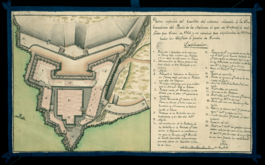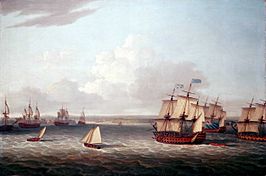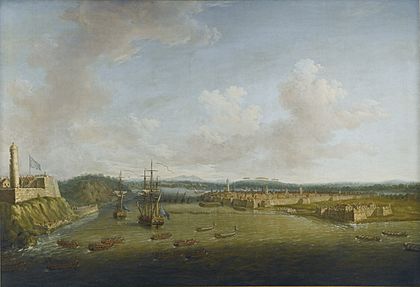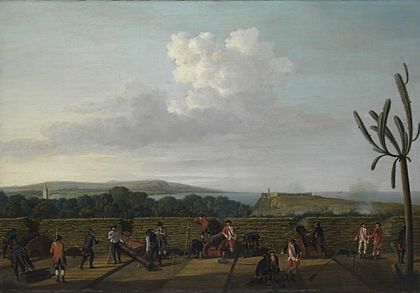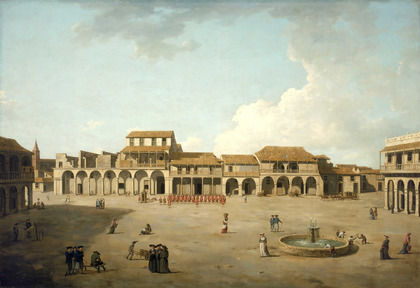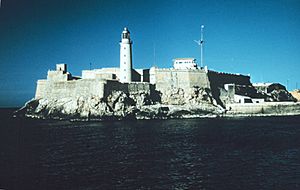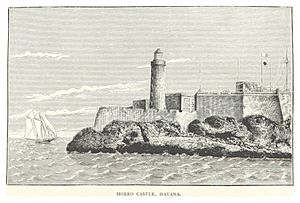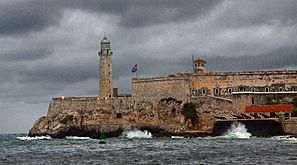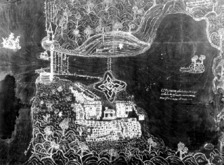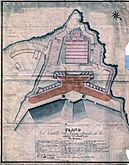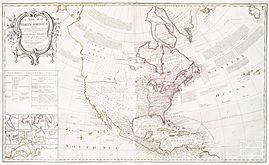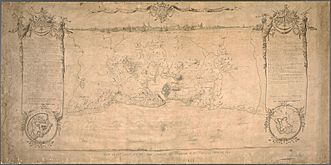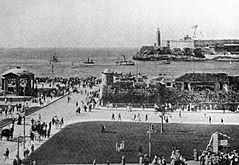Morro Castle (Havana) facts for kids
Quick facts for kids General information |
|
|---|---|
| Town or city | Havana |
| Country | Cuba |
| Coordinates | 23°09′01.67″N 82°21′23.99″W / 23.1504639°N 82.3566639°W |
| Completed | 1589 |
| Technical details | |
| Structural system | Load bearing |
| Material | Masonry |
| Design and construction | |
| Engineer | Battista Antonelli |
Morro Castle (Spanish: Castillo de los Tres Reyes del Morro), also known as the Castle of the Three Magi Kings of Morro, is a strong fortress that protects the entrance to Havana harbor. It was named after the three biblical Magi, or Wise Men, who visited Jesus after his birth.
The castle was designed by an Italian engineer named Battista Antonelli. Spain first controlled the fortress. In 1762, the British captured it. A year later, it was given back to Spain as part of the Treaty of Paris (1763). Morro Castle was Havana's main defense until La Cabaña fortress was finished in 1774.
Contents
History of Morro Castle
Morro Castle sits on a high piece of land across the harbor from Old Havana. You can see it from far away, as it guards the harbor entrance. It was built in 1589 because of many attacks on the city. The castle protected the harbor entrance with a large chain stretched across the water. This chain, called a boom defense, connected to the fort at La Punta.
The word "morro" in Spanish means a rock that can be seen from the sea. It acts as a landmark for ships. Morro Castle is part of the Old Havana World Heritage Site. This site was recognized in 1982 for its important role in the European exploration of the New World and its special mix of building styles.
Cuba's Defenses and Attacks (1500s–1700s)
Colonial Cuba was often attacked by buccaneers, pirates, and French privateers. These groups wanted Spain's riches from the New World. To stop these attacks, Spain built stronger defenses across the island in the 1500s. In Havana, the Morro Castle was built to keep invaders away.
One famous English privateer, Francis Drake, sailed near Havana but did not land. In 1628, a Dutch fleet led by Piet Heyn stole from Spanish ships in Havana's harbor. This showed that Havana needed better defenses. In 1662, an English pirate named Christopher Myngs captured Santiago de Cuba for a short time.
About a century later, the British Royal Navy tried another invasion. They captured Guantánamo Bay in 1741 during the War of Jenkins' Ear. However, British troops faced Spanish attacks and a disease outbreak, forcing them to leave. Later, during the War of the Austrian Succession, the British tried to attack Santiago de Cuba again but failed.
The Seven Years' War began in 1754. Spain joined forces with France, which led to conflict with Britain. In 1762, a British force sailed from Portsmouth to capture Cuba. They arrived on June 6 and began to surround Havana. When Havana surrendered, the British took control of the western part of the island. This opened up trade with British colonies in North America and the Caribbean.
The British occupation of Havana was short. Less than a year after taking the city, the Peace of Paris was signed. This treaty ended the Seven Years' War. Britain received Florida from Spain in exchange for Cuba.
The Siege of Havana (1762)
Morro Castle first saw battle in 1762. The British expedition against Cuba landed nearby and attacked the fortress from the land side. The fort fell when the British successfully used mines to blow up one of its walls. When the British gave the island back to Spain in 1763, the fortress at La Cabaña was built to stop future land attacks.
The siege of Havana was a successful British attack on Spanish-ruled Havana. It lasted from March to August 1762, as part of the Seven Years' War. Spain had joined France, leading Britain to declare war in January 1762. The British wanted to weaken Spain's power in the Caribbean.
A strong British navy and army approached Havana from an unexpected direction. They trapped the Spanish fleet in the harbor and landed troops easily. The Spanish leaders decided to delay the British attack. They hoped that the city's strong defenses and the start of the rainy season would weaken the British forces with tropical diseases.
However, the main fortress, Morro Castle, was overlooked by a hill that the Spanish governor had not fortified. The British set up cannons there and bombed the fortress daily. The fortress eventually fell after its commander, Luis Vicente de Velasco, was badly wounded. The capture of Morro Castle led to the fall of the other defenses and the surrender of the city.
The Attack on El Morro
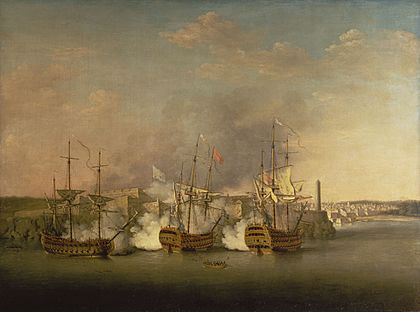
On June 11, British soldiers stormed a small fort on the La Cabana heights. Only then did the British realize how strong Morro Castle was, surrounded by thick bushes and a deep ditch. The next day, the British began setting up cannons on La Cabana hill, which overlooked the Morro. This hill was surprisingly left undefended by the Spanish.
By June 22, British cannons began firing on the Morro. The British slowly moved their defenses closer to the ditch. By the end of June, they were hitting the Morro about 500 times a day. Commander Velasco was losing many men each day, and repairing the fort was very tiring.
On June 29, Spanish soldiers attacked the British cannons, but the British quickly fought them off. On July 1, the British launched a combined attack from land and sea. However, the naval cannons were not effective because the fort was too high. The Morro's cannons hit the British ships, forcing them to retreat.
Meanwhile, the land attack was much more effective. By the end of the day, only three Spanish cannons were still working. The next day, British defenses around the Morro caught fire and were destroyed. Velasco quickly used this chance to fix many cannons and repair the fort's walls.
The British army was suffering greatly from diseases like malaria and yellow fever. Many soldiers were sick. As hurricane season was coming, the British commander, Albemarle, was in a race against time. He ordered the cannons to be rebuilt with help from the navy.
By July 17, the new British cannons had silenced most of Velasco's guns. Without cannon cover, Spanish troops could not repair the damage to the Morro. The British were also able to continue digging tunnels towards the fortress.
On July 22, 1,300 Spanish soldiers attacked the British tunnels around the Morro. The British pushed them back, and the tunnels remained mostly intact. On July 24, Albemarle offered Velasco a chance to surrender, but Velasco refused. Three days later, British reinforcements arrived from North America.
On July 29, the mine tunnel near the Morro fort was ready to explode. The British set off the mine. The explosion partly filled the ditch, and the British launched an attack. Sixteen men quickly got onto the fort's wall. Velasco rushed to the breach with his troops and was badly wounded in the hand-to-hand fighting. The Spanish troops retreated, and the British took control of Morro fort. Velasco died from his wounds on July 31.
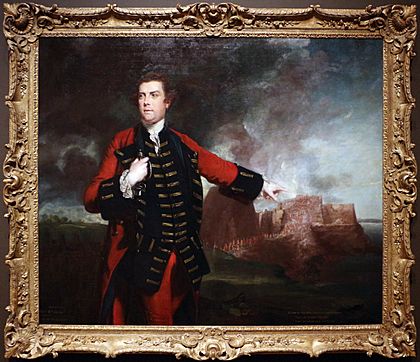
After taking Morro Castle, the British had a strong position overlooking Havana and the bay. They set up cannons that could fire directly on the city.
Havana Surrenders
On August 11, the British cannons opened fire on Havana. They pounded the city from a distance. By the end of the day, Fort La Punta was silenced. The Spanish governor had no choice but to surrender.
The next day, the governor learned there was only enough ammunition for a few more days. He tried to move the city's treasures, but Havana was surrounded. The terms of surrender for the city and the fleet were agreed upon on August 13. The Spanish fleet was left intact and fell into British hands.
After the Siege
On August 14, the British entered Havana. They gained control of the most important harbor in the Spanish West Indies. They also took military equipment, a lot of money, and goods. Nine Spanish warships, which was a big part of the Spanish Navy, were captured in Havana harbor. Two new ships being built were burned.
The British commanders received large rewards for their victory. Other officers and soldiers also received prize money. The Spanish governor and other officials were put on trial when they returned to Spain. They were blamed for not defending Havana better and for letting the Spanish fleet be captured. The governor was found guilty and died in prison.
During the siege, the British lost many soldiers to fighting and disease. After the siege, even more died from sickness. Three British warships were lost due to damage from the fighting.
The loss of Havana was a big blow to Spain. It cost them a lot of money and hurt their reputation. This defeat, along with the British capture of Manila, showed how weak the Spanish Empire was. These events led Spain to make big changes to its military and government in its colonies.
Spain realized its regular army in Cuba was not strong enough against the British. So, they decided to create a well-trained local army, or militia. This militia would have good weapons and training, led by experienced officers. Havana was returned to Spain in February 1763 as part of the Treaty of Paris (1763). Spain also gave Florida to Great Britain.
Visiting El Morro Today
El Morro once had a school for lighthouse keepers. There was a watchtower here, but the British blew it up during their siege in 1762. The Faro Castillo del Morro lighthouse was added in 1846.
The cannons around the fort are now rusty, but the walls are well preserved. The fort has central barracks that are four stories high. You can also find a small underwater archeology exhibit here. The old bathrooms and their chute into the sea are interesting, as are the two sets of doors and the drawbridge. The harbor master's office is still located in the fortress. A plaque from the United Kingdom remembers the 1762 siege.
A small tower at the end of the wall offers views of the sea crashing onto the rocks below. You can also see the huge dry moat. On the other side of the moat, there are more modern guns and cannons, called La Bateria de Velasco. From there, you get a wide view down to Cojimar.
The 9 PM Cannon Shot
Every night at 9 PM, a cannon is fired. This custom, called "El Cañonazo de las 9", comes from colonial times. It used to signal that the city gates were closing for the night.
Morro Castle in Culture
Art
Morro Castle can be seen in the background of John Singleton Copley's painting Watson and the Shark (1778).
Film
Morro Castle appears in the movie The Ghost Breakers (1940). You can see it in the background as the characters enter the harbor by ship.
The final scenes from The Big Boodle (1957), starring Errol Flynn, were filmed at Morro Castle.
The Cuban poet and novelist Reinaldo Arenas (1943-1990) was imprisoned at El Morro Castle. This happened because he criticized the government. The movie Before Night Falls (2000), which is about Arenas's life, shows scenes set in El Morro Castle prison. (A fortress in Mexico City was used for filming, as they could not film in Cuba.)
Literature
The Cuban writer José Antonio Echeverría (1815-1885) wrote a novel called Antonelli (1839). This historical novel tells the story of a love triangle involving Antonelli, a Spanish soldier, and a planter's daughter. Many events in the book, including its sad ending, take place at Morro Castle.
Images for kids
-
Morro castle and La Punta protected the entrance of the harbor with a chain strung out across the water, known as the boom defense. Drawing by Francisco Calvillo, 1576
See also
 In Spanish: Castillo de los Tres Reyes Magos del Morro para niños
In Spanish: Castillo de los Tres Reyes Magos del Morro para niños
- List of buildings in Havana
- Charles III of Spain
- Treaty of Paris (1763)
- Batería de la de la Reina
- Castillo San Salvador de la Punta
- Santa Clara Battery
- Castillo del Príncipe (Havana)
- La Cabaña
- Timeline of Havana


